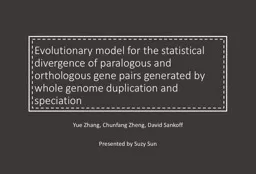

Yue Zhang Chunfang Zheng David Sankoff Presented by Suzy Sun Seeks to infer the nature and timing of evolutionary events by examining the distribution of similarities between orthologous and paralogous gene pairs ID: 637360
Download Presentation The PPT/PDF document "Evolutionary model for the statistical d..." is the property of its rightful owner. Permission is granted to download and print the materials on this web site for personal, non-commercial use only, and to display it on your personal computer provided you do not modify the materials and that you retain all copyright notices contained in the materials. By downloading content from our website, you accept the terms of this agreement.
Slide1
Evolutionary model for the statistical divergence of paralogous and orthologous gene pairs generated by whole genome duplication and speciation
Yue Zhang, Chunfang Zheng, David SankoffPresented by Suzy Sun Slide2
Seeks to infer the nature and timing of evolutionary events by examining the distribution of similarities between orthologous and paralogous gene pairs Identify peaks as duplications that were generated by speciation or whole genome duplication (WGD) events
However, there is no rigorous methodology to calculate the volume of the individual normal distributions
Comparative Genomics
IntroductionSlide3
Analyze duplicate gene similarity distributions based on sequence divergence and fractionation of duplicate genes that result from whole genome duplication (WGD) forSeries of 2 or 3 WGD
Whole genome triplication followed by WGDTriplication, followed by speciation, then WGDCalculate probabilities of possible gene pairs to predict the number of surviving pairs from each event
Purpose
IntroductionSlide4
Speciation creates a set of orthologous gene pairs that evolve through random single nucleotide mutations
Whole genome duplication (WGD) creates a set of paralogous gene pairs that also diverge through random mutationFractionation: one of the two genes is excised, pseudogenized, or otherwise removed as a coding gene
Gene events
IntroductionSlide5
p = proportion of nucleotide positions occupied by the same base in two orthologues/paralogs
G = gene length (number of nucleotides in the coding region) Assume p follows a normal approximation to the sum of G binomial distributions, divided by G
, over time
t
ϵ [0,∞) since the event that gave rise to the gene pair
Mean: E[
p
] =
+
[0,1]
Variance: E(
p
-E[
p
])
2
=
Where
Building blocks
IntroductionSlide6
Fractionation can be represented by u
[0,1]u = probability, for a pair of genes, that neither gene is lost over a time interval t The assumption that any gene pair has a constant probability of fractionation is u
=
where
is the fractionation parameter
Building blocks
IntroductionSlide7
Consider 4 cases:
Two WGDThree WGD
Whole genome triplication followed by WGD
Whole genome triplication, followed by speciation, followed by WGD
GENE EVENTSSlide8
Two WGD
Two WGDSlide9
Two WGD
Two WGD
u
is the probability, for a pair of genes, that neither gene is lost over the time interval t
1,
and similarly,
v
for time
interval
t
2Slide10
Two WGD
Two WGD
u
is the probability, for a pair of genes, that neither gene is lost over the time interval t
1,
and similarly,
v
for time
interval
t
2Slide11
Two WGD
Two WGD
In Figure 1, let
A
=
E
(
t
1
pairs)
=
4
uv
2
+ 4
uv
(1-
v
) +
u
(1-
v)
2
=
u
(1+
v
)
2
B
=
E
(
t
2
pairs)
=
2
uv
2
+ 2
uv
(1-
v
) + (1-
u)v
=
v
(1+
u)
C
=
E
(unpaired genes)
=
(1-
u
)(1-
v
)Slide12
Two WGD
Two WGD
In Figure 1, let
P(A)
=
Proportion
of
t
1
pairs
=
P(B)
=
Proportion
of
t
2
pairs
=
P
(C)
=
Proportion
of
unpaired
=
In Figure 1, let
P(A)
=
Proportion
of
t
1
pairs
=
P(B)
=
Proportion
of
t
2
pairs
=
P
(C)
=
Proportion
of
unpaired
=Slide13
Two WGD
Two WGD
Let
N
p
(s) = the density at point
s
of a normal distribution with mean
p
and variance
Probability that a gene pair will have similarity
Probability of an unpaired gene is
The likelihood of a dataset with gene pairs at s
1
,
…,s
l
and
k
unpaired genes is
The log likelihood
= log
is
Slide14
Three WGD
Three WGDSlide15
Three WGD
Three WGD
For Figure 2 where
u, v, w
are retention probabilities for
t
1
, t
2
, t
3
E(t
1
pairs) = (1 - 3w
2
+ 2w)uv
2
+ (2 + 6w
2 + 4w)
uv + (1 + w
2 + 2w)uE(t
2
pairs) =
((1 + w
2
+ 2w)u + 1 + w
2
+ 2w)v
E(t
3
pairs) =
-2uv
2
w
2
+ ((2w
2
– w)u + w)v +
uv
+w
E(unpaired) =
(1-u)(1-v)(1-w)Slide16
WG Triplication + WGD
WGT + WGD
E(t
1
pairs) =
(u’+3u’’’)v
2
+(2u’ + 6u’’’)+b+3u’’’
E(t
2
pairs) =
-3u’’’v
3
+3u’’’v
2
+(1+2u’’’-u’)v
E(unpaired) = (
1-u’’’-u’)(1-v)Slide17
Speciation
SpeciationSlide18
Speciation
Speciation
Whole genome triplication (t
1
)
Speciation (t
2
)
WGD in one of the daughter genomes (t
3
)Slide19
Speciation
SpeciationSlide20
Application to
Populus
trichocarpaSlide21
Length is variable among genes and genomes
Duplicate genes are produced not only by WGDAssumption of constant rates of gene divergence Fractionation rates are not well understood
LimitationsSlide22
This is the first model that simultaneously processes duplicate gene divergence and fractionation through the course of evolution of one or more species that underwent WGD
We can predict the location, shape and amplitude of evolutionary signals in pairwise genome comparisons
ConclusionsSlide23
Thank you!